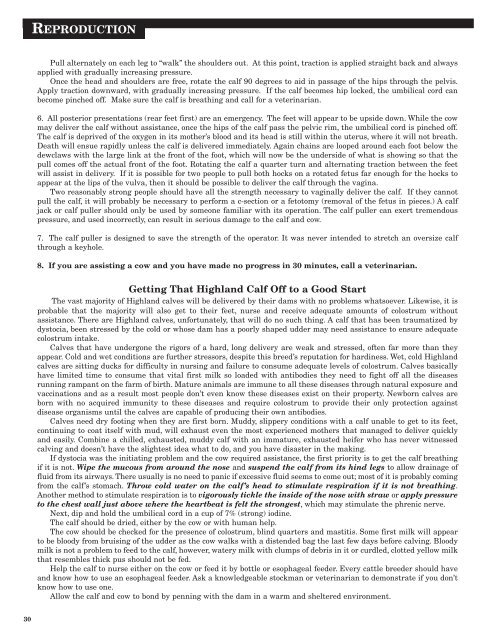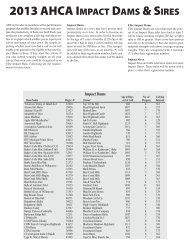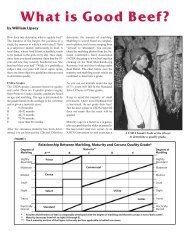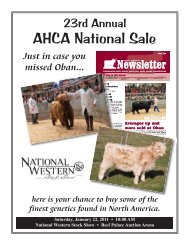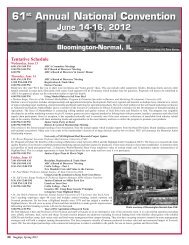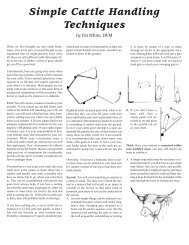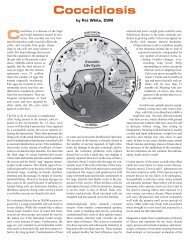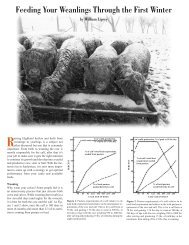The Bagpipe - American Highland Cattle Association
The Bagpipe - American Highland Cattle Association
The Bagpipe - American Highland Cattle Association
You also want an ePaper? Increase the reach of your titles
YUMPU automatically turns print PDFs into web optimized ePapers that Google loves.
30<br />
REPRODUCTION<br />
Pull alternately on each leg to “walk” the shoulders out. At this point, traction is applied straight back and always<br />
applied with gradually increasing pressure.<br />
Once the head and shoulders are free, rotate the calf 90 degrees to aid in passage of the hips through the pelvis.<br />
Apply traction downward, with gradually increasing pressure. If the calf becomes hip locked, the umbilical cord can<br />
become pinched off. Make sure the calf is breathing and call for a veterinarian.<br />
6. All posterior presentations (rear feet first) are an emergency. <strong>The</strong> feet will appear to be upside down. While the cow<br />
may deliver the calf without assistance, once the hips of the calf pass the pelvic rim, the umbilical cord is pinched off.<br />
<strong>The</strong> calf is deprived of the oxygen in its mother’s blood and its head is still within the uterus, where it will not breath.<br />
Death will ensue rapidly unless the calf is delivered immediately. Again chains are looped around each foot below the<br />
dewclaws with the large link at the front of the foot, which will now be the underside of what is showing so that the<br />
pull comes off the actual front of the foot. Rotating the calf a quarter turn and alternating traction between the feet<br />
will assist in delivery. If it is possible for two people to pull both hocks on a rotated fetus far enough for the hocks to<br />
appear at the lips of the vulva, then it should be possible to deliver the calf through the vagina.<br />
Two reasonably strong people should have all the strength necessary to vaginally deliver the calf. If they cannot<br />
pull the calf, it will probably be necessary to perform a c-section or a fetotomy (removal of the fetus in pieces.) A calf<br />
jack or calf puller should only be used by someone familiar with its operation. <strong>The</strong> calf puller can exert tremendous<br />
pressure, and used incorrectly, can result in serious damage to the calf and cow.<br />
7. <strong>The</strong> calf puller is designed to save the strength of the operator. It was never intended to stretch an oversize calf<br />
through a keyhole.<br />
8. If you are assisting a cow and you have made no progress in 30 minutes, call a veterinarian.<br />
Getting That <strong>Highland</strong> Calf Off to a Good Start<br />
<strong>The</strong> vast majority of <strong>Highland</strong> calves will be delivered by their dams with no problems whatsoever. Likewise, it is<br />
probable that the majority will also get to their feet, nurse and receive adequate amounts of colostrum without<br />
assistance. <strong>The</strong>re are <strong>Highland</strong> calves, unfortunately, that will do no such thing. A calf that has been traumatized by<br />
dystocia, been stressed by the cold or whose dam has a poorly shaped udder may need assistance to ensure adequate<br />
colostrum intake.<br />
Calves that have undergone the rigors of a hard, long delivery are weak and stressed, often far more than they<br />
appear. Cold and wet conditions are further stressors, despite this breed’s reputation for hardiness. Wet, cold <strong>Highland</strong><br />
calves are sitting ducks for difficulty in nursing and failure to consume adequate levels of colostrum. Calves basically<br />
have limited time to consume that vital first milk so loaded with antibodies they need to fight off all the diseases<br />
running rampant on the farm of birth. Mature animals are immune to all these diseases through natural exposure and<br />
vaccinations and as a result most people don’t even know these diseases exist on their property. Newborn calves are<br />
born with no acquired immunity to these diseases and require colostrum to provide their only protection against<br />
disease organisms until the calves are capable of producing their own antibodies.<br />
Calves need dry footing when they are first born. Muddy, slippery conditions with a calf unable to get to its feet,<br />
continuing to coat itself with mud, will exhaust even the most experienced mothers that managed to deliver quickly<br />
and easily. Combine a chilled, exhausted, muddy calf with an immature, exhausted heifer who has never witnessed<br />
calving and doesn’t have the slightest idea what to do, and you have disaster in the making.<br />
If dystocia was the initiating problem and the cow required assistance, the first priority is to get the calf breathing<br />
if it is not. Wipe the mucous from around the nose and suspend the calf from its hind legs to allow drainage of<br />
fluid from its airways. <strong>The</strong>re usually is no need to panic if excessive fluid seems to come out; most of it is probably coming<br />
from the calf’s stomach. Throw cold water on the calf’s head to stimulate respiration if it is not breathing.<br />
Another method to stimulate respiration is to vigorously tickle the inside of the nose with straw or apply pressure<br />
to the chest wall just above where the heartbeat is felt the strongest, which may stimulate the phrenic nerve.<br />
Next, dip and hold the umbilical cord in a cup of 7% (strong) iodine.<br />
<strong>The</strong> calf should be dried, either by the cow or with human help.<br />
<strong>The</strong> cow should be checked for the presence of colostrum, blind quarters and mastitis. Some first milk will appear<br />
to be bloody from bruising of the udder as the cow walks with a distended bag the last few days before calving. Bloody<br />
milk is not a problem to feed to the calf, however, watery milk with clumps of debris in it or curdled, clotted yellow milk<br />
that resembles thick pus should not be fed.<br />
Help the calf to nurse either on the cow or feed it by bottle or esophageal feeder. Every cattle breeder should have<br />
and know how to use an esophageal feeder. Ask a knowledgeable stockman or veterinarian to demonstrate if you don’t<br />
know how to use one.<br />
Allow the calf and cow to bond by penning with the dam in a warm and sheltered environment.


